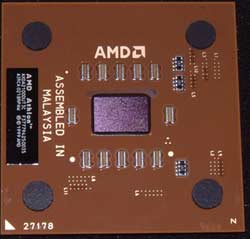 With AMD's
0.13 micron core Thoroughbred-based Athlon XP's we should see a some nice healthy boosts in
speeds over the next one or two quarters. Stock speed performance is
where you would expect it, and is quite good. Overclockers will tend to find
the T-Bred a little less friendly however.
With AMD's
0.13 micron core Thoroughbred-based Athlon XP's we should see a some nice healthy boosts in
speeds over the next one or two quarters. Stock speed performance is
where you would expect it, and is quite good. Overclockers will tend to find
the T-Bred a little less friendly however.
Thermally, the new AthlonXP T-Breds produce almost as much
heat as their 0.18 micron Palomino counter parts, and with a smaller contact area proper
cooling becomes even more of a concern.
Performance of the processor is excellent (as we've
become accustomed to seeing from the Athlon) but it is still not quite enough
to beat a highly clocked Pentium.
Of course as Intel clock speeds near the 3.0GHz mark, AMD has
shifted their focus towards the value role where AMD based computers trounce out Intel in just about
every case.
As a performance enthusiast I'll be honest here; I
was caught up in the hype before the T-Bred release about
how well it might overclock. After the initial wave of reviews, my enthusiasm settled down
a bit but I felt confident I could still push the AthlonXP T-Bred higher then the other
guys. The XP2000+ T-Bred we tested was able to overclock to 1.9 GHz, but then
again so could a XP2100+ on the Palomino core. While overclocking
only counts for part of the equation in how well a new processor is received, we
can always hope that AMD engineers will lay things down in the future
with an eye towards the performance users, and the mainstream public
evenly.
The T-Bred is a good processor compared to the more expensive Intel
offerings, and would probably be a better choice for a gamers system. AMD still
has a lot of work to do ramping up the high end speed of the
AthlonXP T-Bred so that they can equally compete with the latest chips from
Intel on the Northwood core. Hopefully some further optimization with the
0.13micron process will allow AMD engineers to squeeze even more performance
from the T-bred core. For the moment, the T-Bred Athlon XP offers users a small
increase in performance over the equivalent Palomino core, but the true
colour is really only visible when overclocked... the Barton will be the real
test of 0.13micron, but that is still a ways away. Most significantly, the
AthlonXP 2000+/2100+ offers a pretty good value for consumers, but that may be
tempered with the louder cooling solutions it will
require.
